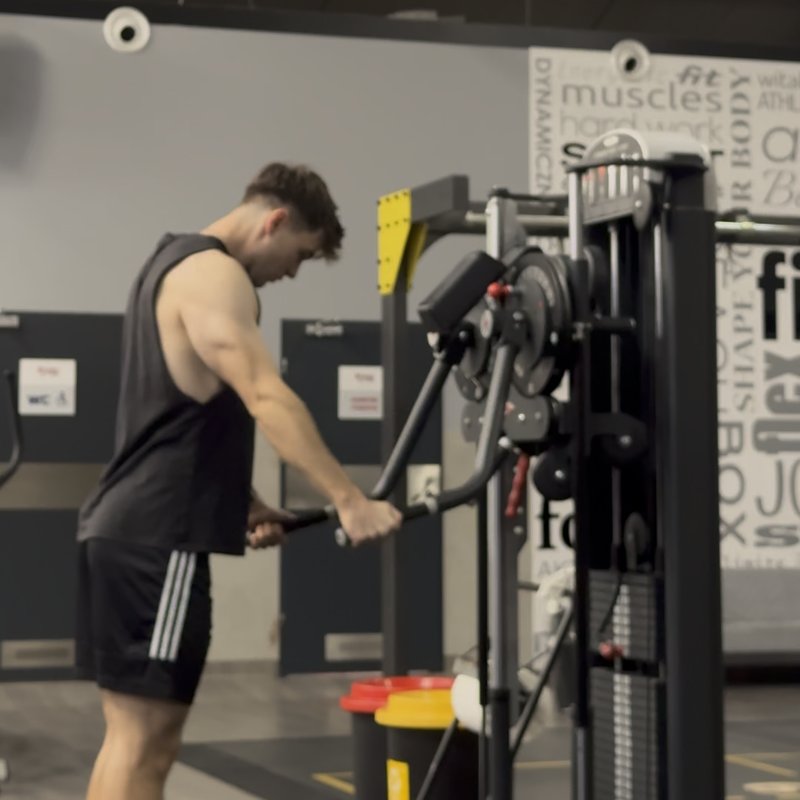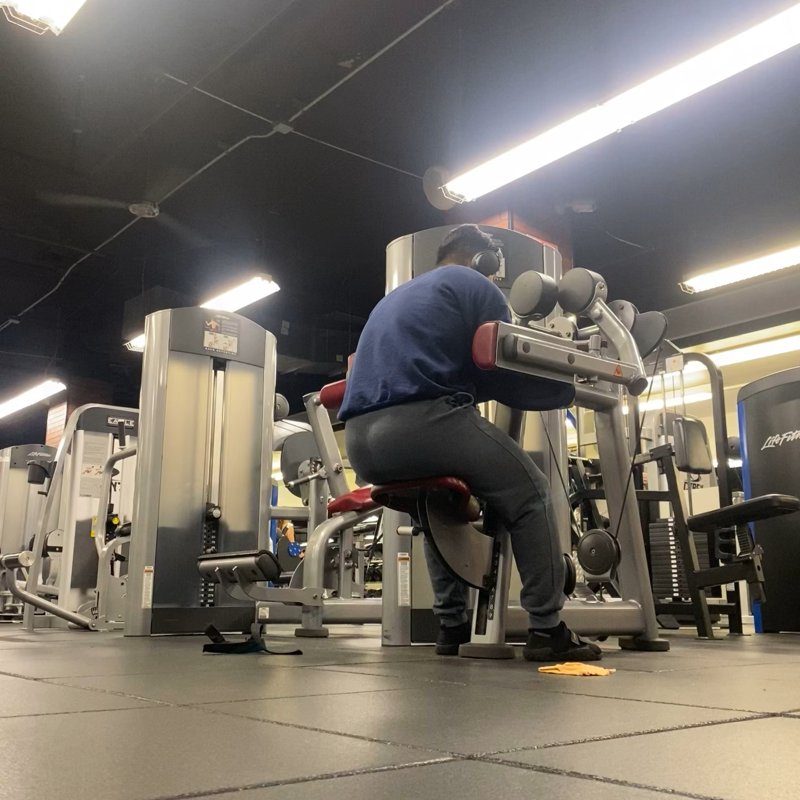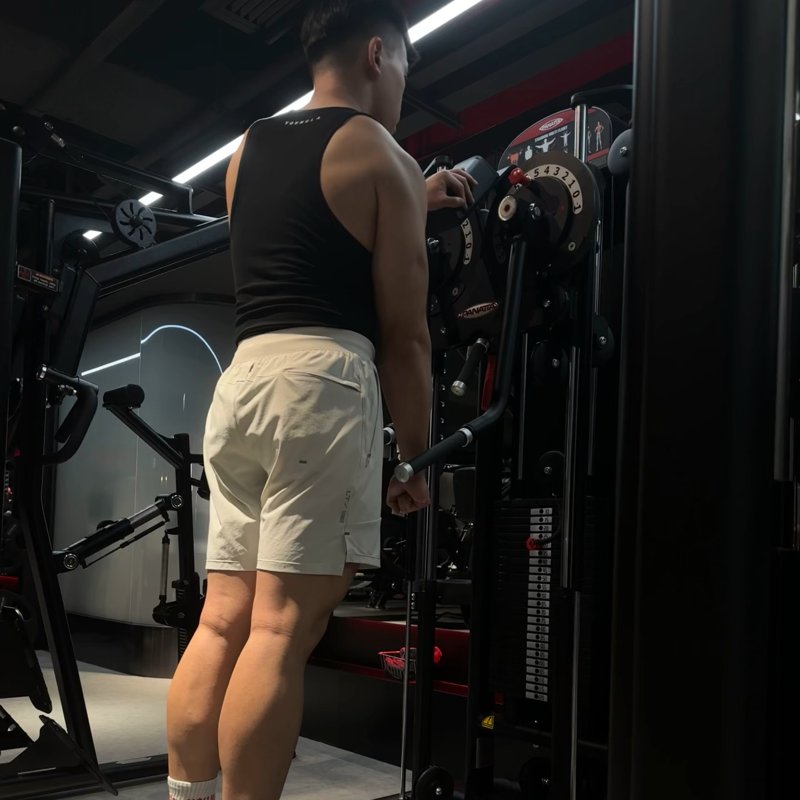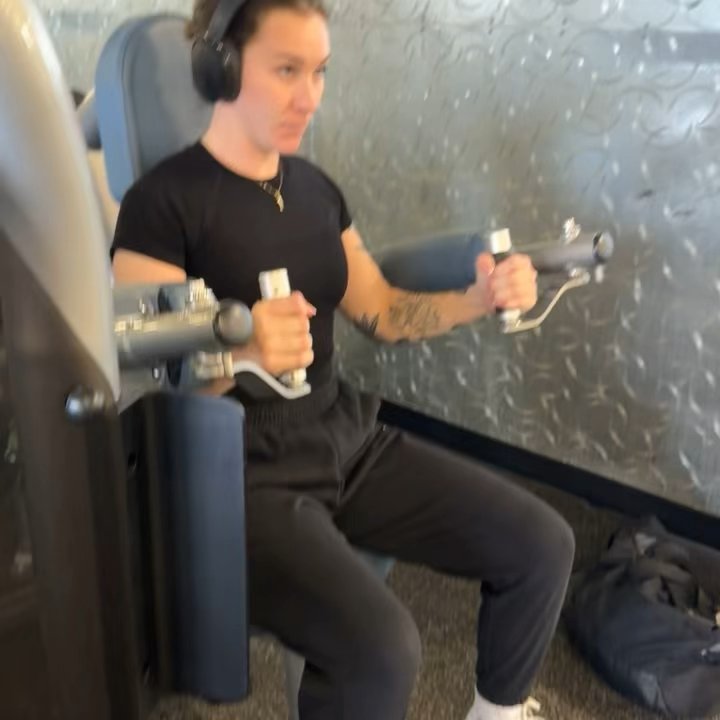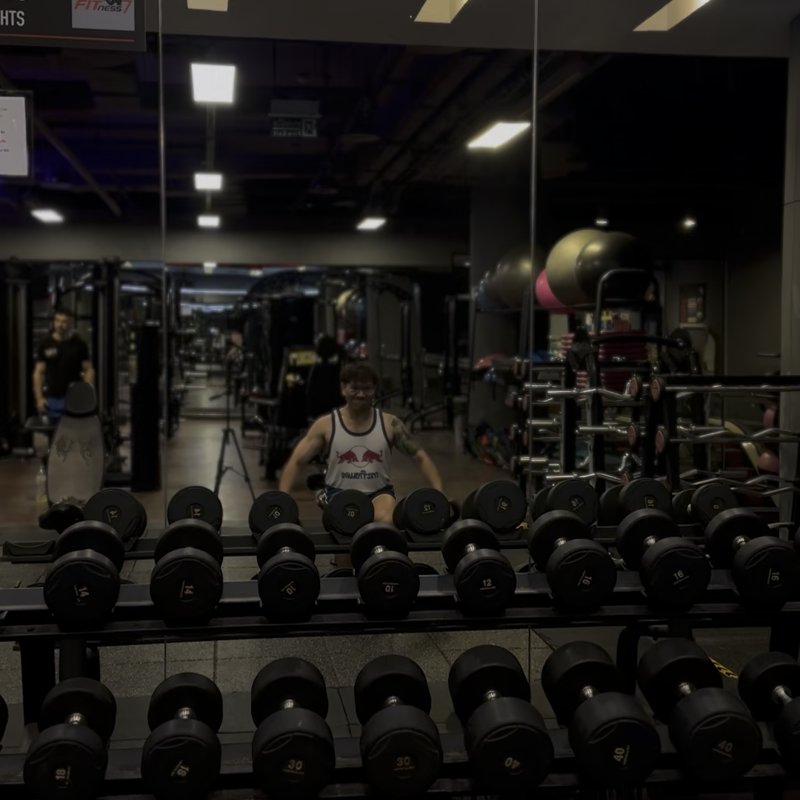Lateral Raise Cable: The Ultimate Guide
The Cable Lateral Raise is an isolation exercise that targets the lateral deltoids using cable resistance to maintain constant tension throughout the movement, making it excellent for shoulder width and development.
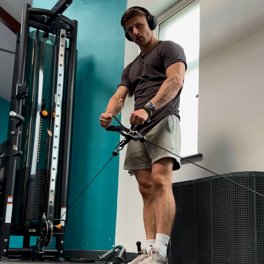
Quick Facts
Key Benefit
Lateral deltoid development with consistent resistance
Primary Muscles
Medial Deltoids
Secondary Muscles
Abdominals, Anterior Deltoids, Posterior Deltoids, Traps
Equipment
cable machine
Difficulty
Beginner
Type
Isolation
In This Guide
Ready to master the Lateral Raise Cable?
Track your progress, see improvements over time, and build strength consistently.
Download GravitusThe Cable Lateral Raise is an excellent isolation exercise that specifically targets the lateral (middle) deltoid—the shoulder muscle primarily responsible for creating that coveted shoulder width and cap. While similar to its dumbbell counterpart in basic movement pattern, the cable variation offers unique benefits that make it a valuable addition to any shoulder training program. What distinguishes the cable version is the constant tension it provides throughout the entire range of motion. Unlike dumbbells, which lose significant tension at the bottom of the movement due to gravity's straight-down pull, cables maintain resistance throughout the exercise by providing tension in the direction of the pulley. This consistent tension not only increases time under tension—a key factor for muscle growth—but also allows for a more controlled eccentric (lowering) phase, which research suggests may be particularly important for hypertrophy. Additionally, the cable's line of pull can be adjusted to target the deltoids from slightly different angles for comprehensive development. Whether your goal is to build wider shoulders, create balanced deltoid development, or add variety to your shoulder training, the Cable Lateral Raise delivers targeted stimulation in a joint-friendly manner that can be scaled to any fitness level.
Benefits of Cable Lateral Raises
The cable variation offers several unique advantages compared to other lateral raise variations.
Constant Tension
The cable provides consistent resistance throughout the entire movement, eliminating the "dead spot" at the bottom that occurs with free weights.
Customizable Resistance Curve
By adjusting your position relative to the cable, you can modify the resistance profile to make the exercise harder or easier at different points in the range of motion.
Reduced Momentum
The nature of cable resistance makes it more difficult to use body english or momentum to swing the weight up, ensuring better isolation of the target muscles.
Joint-Friendly Options
The ability to adjust the angle of pull often makes cable variations more comfortable for those with shoulder issues compared to traditional dumbbell raises.
Unilateral Training
Performing the exercise one arm at a time allows for identifying and addressing strength imbalances between sides.
Proper Form & Technique
Setup
- Adjust a cable pulley to the lowest position.
- Attach a single handle to the cable.
- Stand alongside the cable machine with your feet shoulder-width apart.
- Grasp the handle with your outside hand (the hand furthest from the machine).
- Position yourself far enough away from the machine to maintain tension on the cable at the starting position.
- Stand tall with a slight bend in your knees, core engaged, and shoulders pulled back and down.
- The working arm should start across your body with the handle positioned near your opposite hip or thigh.
- Your palm should face your body or be slightly turned down in a neutral-to-pronated grip.
- Maintain a slight bend in your elbow throughout the entire exercise—approximately 10-15 degrees.
- Your non-working hand can rest on your hip or grasp a stable support for balance if needed.
Movement
- Begin by taking a deep breath and engaging your core.
- Initiate the movement by raising your arm out to the side, leading with your elbow rather than your hand.
- Keep your arm slightly bent but maintain the same elbow angle throughout—don't bend or straighten as you lift.
- Raise your arm until it reaches approximately shoulder height or slightly above (your arm should be parallel to the floor or slightly higher).
- Focus on using your lateral deltoid to power the movement, not your trapezius or other muscles.
- Maintain an upright torso—avoid leaning to generate momentum.
- At the top position, your palm should face downward (think about pouring a glass of water).
- Hold the contracted position briefly (1-2 seconds) to maximize muscle activation.
- Slowly lower your arm back to the starting position with control, resisting the pull of the cable.
- Maintain tension throughout the entire movement—don't allow the weight stack to rest between repetitions.
- Complete all repetitions on one side before switching to the other arm.
Key Form Tips
Elbow Position
Maintain a slight, consistent bend in your elbow throughout the movement—neither completely straight nor excessively bent.
Shoulder Position
Keep your shoulders down and back, avoiding the tendency to shrug as your arm rises.
Wrist Alignment
Maintain a neutral wrist position throughout the movement, avoiding flexion or extension.
Range of Motion
Raise your arm to shoulder height or slightly above for optimal lateral deltoid activation without excessive trapezius involvement.
Control
Focus on slow, controlled movement, especially during the lowering phase, to maximize time under tension.
Muscles Worked
Primary Muscles
- medial deltoids: The middle head of the deltoid muscle that forms the rounded contour of the shoulder is the primary target, responsible for abduction of the arm away from the body.
Secondary Muscles
- anterior deltoids: The front portion of the shoulder muscle assists in the movement, particularly during the initial phase of the lift.
- posterior deltoids: The rear head of the deltoid provides stability and minor assistance throughout the movement.
- supraspinatus: One of the rotator cuff muscles that initiates abduction of the arm and works alongside the deltoids during the early phase of the movement.
- traps: The upper portion of the trapezius muscle provides stability and may become engaged, particularly if the arm is raised above shoulder height.
- serratus anterior: The "boxer's muscle" assists in stabilizing the shoulder blade during the movement.
- abdominals: The abdominals and obliques work isometrically to maintain proper posture and resist the rotational force of the cable.
Common Mistakes and How to Fix Them
Using Too Much Weight
Selecting a weight that's too heavy often leads to using momentum and improper form, reducing lateral deltoid activation. Choose a weight that allows you to perform the movement with strict form while feeling the targeted muscle working. If you find yourself swinging, leaning, or using momentum to move the weight, it's too heavy. Remember that lateral raises are an isolation exercise where form and mind-muscle connection are more important than the amount of weight used. Start lighter than you think necessary and focus on perfect execution before gradually increasing the resistance.
Shrugging the Shoulders
Elevating the shoulders toward the ears during the movement shifts work from the deltoids to the trapezius. Keep your shoulders pulled down and back throughout the entire exercise. Before beginning each rep, consciously depress your shoulder blades, creating distance between your ears and shoulders. Maintain this position as you raise your arm. If you notice shoulder elevation occurring, it may indicate the weight is too heavy or that you're raising your arm too high. Consider performing some sets in front of a mirror to monitor shoulder position until proper form becomes habitual.
Lifting Too High
Raising the arm significantly above shoulder level can lead to impingement issues and shifts emphasis away from the lateral deltoid. Stop the upward movement when your arm is approximately parallel to the floor or just slightly above. If you're consistently raising higher, it may be due to momentum, excessive trapezius involvement, or simply a misunderstanding of proper form. Use a mirror to check your endpoint, or have a training partner provide feedback. Remember that the goal is targeted lateral deltoid work, not simply moving the arm as high as possible.
Using Momentum
Swinging the body or using momentum to move the weight reduces the effectiveness of the exercise and increases injury risk. Control the movement throughout the entire range of motion, especially during the lowering phase. Implement a deliberate tempo—for example, 2 seconds up, 1-second pause at the top, 3 seconds down—to eliminate momentum. Focus on feeling the lateral deltoid doing the work rather than just moving the handle from point A to point B. If maintaining strict form is challenging, reduce the weight until proper execution is possible.
Improper Arm Position
Keeping the arm completely straight or excessively bent changes the leverage and stress on the shoulder joint. Maintain a slight bend in your elbow (approximately 10-15 degrees) throughout the entire movement. This slight bend reduces stress on the elbow joint while optimizing lateral deltoid engagement. The key is keeping the same degree of bend from start to finish—avoid the tendency to straighten the arm as it rises or bend it more as it lowers. Think of your arm as a fixed unit moving solely at the shoulder joint.
Improper Cable Position
Standing too close or too far from the cable machine can alter the effectiveness of the exercise. Position yourself at a distance where there's tension on the cable at the starting position, but not so much that it pulls you off balance. The optimal position typically has the cable coming across your body at a slight angle. Experiment with your positioning relative to the machine to find what creates the strongest lateral deltoid contraction. For most people, standing 1-2 feet away from the machine (perpendicular to it) provides the right angle of resistance.
Exercise Variations
Position Variations
-
High Cable Lateral Raise
Performing the movement with the cable set at a high position, pulling downward and out to the side, creating a different angle of resistance that some find more comfortable for the shoulder joint.
-
Leaning Cable Lateral Raise
Leaning away from the cable machine to create a different angle of pull and increase tension at the bottom portion of the movement.
-
Seated Cable Lateral Raise
Executing the exercise while seated on a bench to eliminate any potential lower body assistance and isolate the shoulder more completely.
-

Cross-Body Cable Lateral Raise
Standing facing away from the machine and pulling the cable across the body and up, creating a unique resistance angle that some find creates stronger lateral deltoid contraction.
Grip Variations
-

Pronated Grip Cable Lateral Raise
Using a fully pronated (palm-down) grip throughout the movement to slightly alter deltoid recruitment patterns.
-
Neutral Grip Cable Lateral Raise
Maintaining a neutral (thumb-up) grip throughout the exercise, which some find more comfortable for the shoulder joint.
-

Rotating Cable Lateral Raise
Beginning with a neutral grip at the bottom and rotating to a pronated position at the top, mimicking the natural rotation of the arm during abduction.
Technical Variations
-
Cable Lateral Raise with Pause
Adding a 2-3 second isometric hold at the top position to increase time under tension and enhance mind-muscle connection.
-

Partial Range Cable Lateral Raise
Performing the movement through a limited range (typically the top half) to maintain constant tension in the area of maximum lateral deltoid contraction.
-

21s Cable Lateral Raise
Performing 7 partial reps in the bottom half of the range, 7 partial reps in the top half, and 7 full range repetitions to thoroughly fatigue the muscle.
-

Drop Set Cable Lateral Raise
Performing a set to near failure, then immediately reducing the weight and continuing for additional repetitions without rest.
Frequently Asked Questions
Neither variation is universally "better"—they each offer distinct advantages that make them complementary rather than competitive. Cable lateral raises provide constant tension throughout the entire range of motion, eliminating the "dead zone" at the bottom of the movement that occurs with dumbbells due to gravity's straight-down pull. This consistent tension can increase time under tension and potentially enhance muscle growth stimulus. The cable version also typically allows for greater control during the eccentric (lowering) phase and makes it more difficult to use momentum. Dumbbell lateral raises, however, offer their own benefits including greater accessibility (requiring minimal equipment), more freedom of movement, and the ability to more easily perform certain variations like bent-over lateral raises for posterior deltoid emphasis. For most trainees, incorporating both variations in a training program provides the most comprehensive development. You might rotate between them across different training sessions or even within the same workout to take advantage of their unique benefits. The "best" choice ultimately depends on your specific goals, equipment availability, individual shoulder mechanics, and personal preference.
For optimal lateral deltoid activation with minimal risk of impingement issues, raise your arm until it reaches approximately shoulder height or slightly above—usually parallel to the floor or up to about 15 degrees higher. This range typically provides maximum lateral deltoid engagement while minimizing excessive trapezius involvement and reducing potential shoulder joint stress. The exact height may vary slightly between individuals based on shoulder anatomy and mobility. Several indicators can help determine your ideal end position: First, you should feel maximum tension in the lateral deltoid at the top of the movement. Second, you should be able to maintain proper form without shrugging your shoulder toward your ear. Third, the movement should feel comfortable without any pinching or pain in the shoulder joint. If you experience discomfort when raising to shoulder height, try a slightly lower end position or experiment with different arm angles (slightly forward or backward from directly lateral). Avoid the common mistake of trying to raise the arm as high as possible, as extreme elevation shifts emphasis to the trapezius and can potentially create shoulder impingement.
To maximize the effectiveness of cable lateral raises, focus on these key techniques: First, prioritize mind-muscle connection by consciously focusing on your lateral deltoid contracting and stretching throughout each repetition. Second, maintain strict form—keep shoulders down away from your ears, use a controlled tempo, maintain a slight consistent elbow bend, and avoid using momentum or body english. Third, experiment with your position relative to the cable machine to find the angle that creates the strongest lateral deltoid contraction for your individual mechanics. Fourth, implement strategic intensity techniques like paused reps (holding the contracted position for 2-3 seconds), drop sets (reducing weight after reaching failure to extend the set), or mechanical drop sets (changing position to work through fatigue). Fifth, ensure proper execution of the negative (lowering) portion of each rep—control the descent rather than just letting the weight fall back. Sixth, consider pre-exhaustion techniques by performing lateral raises before pressing movements to emphasize deltoid development. Finally, ensure you're using an appropriate weight that challenges the muscle while allowing proper form—for most people, this is lighter than they initially expect for this isolation movement.
Most people achieve optimal results training each major muscle group 2-3 times per week, with direct lateral deltoid work like cable lateral raises included in some or all of these sessions. For the average trainee focused on balanced development, performing lateral raises 2 times weekly provides sufficient stimulus while allowing adequate recovery. If shoulders are a particular focus or lagging body part, you might include lateral raise variations in up to 3 weekly sessions, potentially varying the specific exercise (cable, dumbbell, machine) and intensity techniques between workouts. It's important to consider that the deltoids also receive significant indirect work during many pressing movements (bench press, overhead press, push-ups), so total shoulder training volume must be considered, not just direct isolation work. Within each shoulder training session, a typical approach includes 3-4 sets of lateral raises, with total volume potentially higher during specialization phases. Pay attention to recovery indicators—if shoulder performance decreases between sessions or joint discomfort develops, you may need to reduce frequency or volume. Remember that progression (through increased weight, reps, or intensity techniques) is more important than extreme frequency for continued development.
The appropriate weight for cable lateral raises is typically lighter than many people initially expect, as this is a strict isolation exercise targeting a relatively small muscle group. Rather than focusing on a specific number, select a weight that allows you to maintain proper form throughout the entire set while feeling targeted work in the lateral deltoid. For most trainees, this means a weight that creates challenge in the 10-15 repetition range. Signs that you've selected an appropriate weight include: (1) ability to raise the arm to shoulder height without shrugging or using momentum, (2) feeling the work primarily in the lateral deltoid rather than the trapezius or other muscles, (3) maintaining control during both the lifting and lowering phases, and (4) reaching temporary muscle failure or very close to it by the end of the set. If you find yourself using body english, raising your shoulder toward your ear, or swinging to move the weight, it's too heavy. Starting with a lighter weight than you think necessary and focusing on perfect execution is often more productive than using heavier weights with compromised form. As a general reference, many men begin with 5-15 pounds and women with 2.5-10 pounds, though individual strength levels vary significantly.
Video Demonstrations
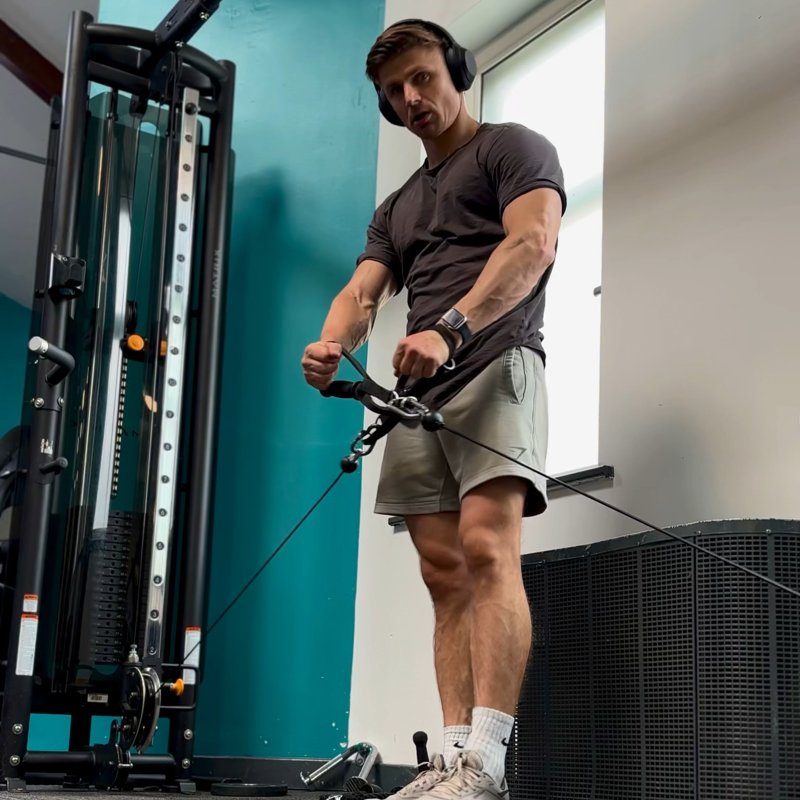
Log in to watch video demonstrations
Login to WatchTips from the Community
-

The
Track your progress with Gravitus
Download Gravitus to log your workouts, track your progress, and join a community of fitness enthusiasts.

Helpful Resources
One Rep Max Calculator
Find your one rep max for any exercise without maximal testing. Essential for developing effective strength training programs.
Calculate 1RMWorkout Programs
Follow structured workout programs created by fitness professionals to maximize your strength and muscle gains.
View Programs